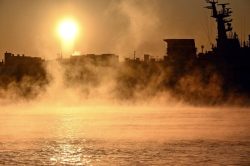
A visitor sits in an ancient sauna in Sanuki, Kagawa Prefecture.
11:25 JST, April 15, 2023
TAKAMATSU — An ancient stone-built sauna believed to have been constructed in the Nara period (710-784) is gaining popularity among fans of high-heat perspiration sessions.
The rural facility in Sanuki, Kagawa Prefecture, comprises a domed “bathhouse” that is filled with steam capable of reaching temperatures of almost 150 C.
Tsukahara no Karafuro is thought to have been built by Gyoki, a high priest, to help “heal” people.
The facility is said to have been particularly popular during the Edo period (1603-1867).
The domed structure houses two stone “karafuro” chambers, measuring 1.2 meters wide and 2.7 meters deep.
Despite being referred to as a “bathhouse,” no hot water is used. Rather, about 120 kilograms of firewood is burned in each chamber for about an hour a day. The burned firewood is then covered with a wet straw mat and doused with salt water, giving rise to room-filling steam.

Firewood is burned in an ancient sauna in Sanuki, Kagawa Prefecture.
The temperature inside the stone-built structure surpasses that of regular saunas, which typically log heats of about 70 C to 110 C. To avoid burns, users of the Sanuki facility wear clothes and sandals and cover themselves with a blanket.
The sauna’s heat-factor has become something of a talking point and has featured in books and social media, helping attract people from across Japan. In fiscal 2022, 4,030 people visited the sauna — about 50% more than in fiscal 2018.
The facility is operated by the Karafuro Hozonkai preservation society, made up of local residents. “We never thought we’d see the day when people from all over the country would visit,” said society representative Kenichi Kobayashi, who explained that the sauna formerly was only patronized by local regulars.
According to Toshihide Innami, professor emeritus of folklore at Aichi University, similar stone bathhouses were introduced from continental China in ancient times and spread throughout Japan along with Buddhism.
In the past, there were many similar bathhouses around the Seto Inland Sea where hot springs were scarce, but by the end of the Showa era, they had mostly closed due to depopulation and a lack of firewood, Innami explained.
“It’s a miracle that the [Sanuki] bathhouse is still in business,” Innami added.
Tsukahara no Karafuro is open from Thursday through Sunday, noon to 9 p.m. Admission is ¥500.
Related Tags
"Features" POPULAR ARTICLE
-

Sanrio to Open Museum in Yamanashi Pref. Dedicated to Founder, Exhibits Include Hello Kitty, Other Characters
-

Autumn Foliage Surrounds Visitors to Tokyo’s Showa Kinen Park
-

My Daughter No Longer Speaks to Me, But I Want to See Her and My Grandchild
-

Kumamoto: Public Bath Refurbished as Library Where You Can Chat, Take Photos
-

Frozen Vegetables: Demand Rises for Convenient, Tasty Domestic Produce
JN ACCESS RANKING
-

Tokyo Economic Security Forum to Hold Inaugural Meeting Amid Tense Global Environment
-

Keidanren Chairman Yoshinobu Tsutsui Visits Kashiwazaki-Kariwa Nuclear Power Plant; Inspects New Emergency Safety System
-

Imports of Rare Earths from China Facing Delays, May Be Caused by Deterioration of Japan-China Relations
-

University of Tokyo Professor Discusses Japanese Economic Security in Interview Ahead of Forum
-

Japan Pulls out of Vietnam Nuclear Project, Complicating Hanoi’s Power Plans

























